- Accueil
- Association
- Album
- Boutique
- Renault Agriculture
- Pièces
- Privilège
- Forum
-







-
 connectés :1
connectés :1

Site développé par Jacques & Jérérmy Gouet

|
© Tous droits réservés Jacques Gouet & ATR 1993-2024
1918 - 1944
This page is available to all; the other pages are reserved for Members Privileges
Extracts
taken from the CD-Rom "Amicale du Tracteur Renault" (1999 -
Jacques Gouet)
and extracts from the "Encyclopédie du Tracteur Renault"
Three volumes (1919-1970) - (1971-2000) - (2000-2005) Editions ETAI
(Reproduced on this site with permission of
ETAI)
|
It was in this modest lean-to, built at the bottom of the family garden at Billancourt, just outside Paris, that the young Louis Renault constructed the first Renault. It was a resounding success; in 1913, production exceeded 10,000 cars. During World War I Renault worked for the Ministry of Defence and notably built the first FT tanks, ensuring the success of the French offensives in 1918.
|
|
|
|
Over the course of this long war, the shortage of manpower and the
requisitioning of horses had an adverse effect on agriculture.
From 1917 Louis Renault began thinking about the
mechanisation
of agricultural
labour,
as shown in this photograph dated 25 January 1918.
After
the War, Department 14 - where the FT tanks were built - was
converted into an assembly workshop for the first mass-produced
farm tractor, the Model GP.From
that point on, Renault turned his attention towards agriculture
and his farm at Herqueville in Normandy became the location for
his test centre. |
The following is an extract from the book “L’usine Renault du Mans: 1918-1945” by Gilbert Hatry .
" The events of the Great War gave the lie to the optimistic forecasts of the military soothsayers, with regard to both the duration of the conflict and the amount of ammunition used.
The Ministry of Defence called upon industry to join forces and Louis Renault found himself compelled to decentralise certain manufacturing operations ; through canvassing Le Mans was retained and a feasibility study, dated 4 December 1918, heralded not only the factory that he wanted to develop, but also his social concerns, with housing developments and spaces for recreation (La Gautrie, sports grounds, etc). A rail connection was to be approved by the National Railway on 27 July 1924.
But it proved to be a long process and production of the agricultural tractors continued in the Billancourt workshops until 1942 .
|
The advancement of mechanisation was directly linked to the
price of fuel which would generate increases that had to be
recouped.
As
a result, the first heavy fuel oil engines appeared in 1927 with
the model RK
|
and
diesel engines in 1932 with the model
VI.
|
|
In the 1930’s, steam was still widely used as a source of
power, particularly for threshing.
In
1932 Renault introduced a heavy fuel oil Locomobile,
fitted with a two-stroke semi-diesel engine fuelled by diesel
oil. Also, it is worth noting that during this same period
Renault was offering a whole range of stationary engines. |
 |
However, the petrol engine retained its followers, reassured by the fine
performance of the Renault 85 engine.
Let us return to the factory at Le Mans; by way of sharing the costs of
decentralisation, General Happic signed a contract on 14 December 1938,
setting up an independent company,
Société
Anonyme des Usines de Pontlieue (Factories of Pontlieue Ltd),
guaranteeing an order of a certain number of tracked vehicles at an
enhanced price.
This plant was to be located on the site of Unit 7; the company articles
allowed for the facility to bring together the manufacturing of special
vehicles, engines, agricultural tractors and various other vehicles. It
was from this point onwards that Le Mans became the manufacturer of the
Renault tractor; you can see from the table below how the works
progressed.
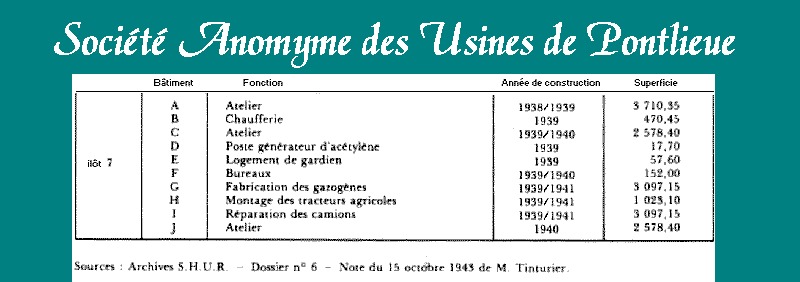
The Occupation brought its share of requisitioning and the factory at
Pontlieue, well suited to heavy machinery, paid the price. In 1940
Junker set up in Renault’s premises; Renault was prohibited from
manufacturing tractors, but through sheer determination, Renault
obtained permission to build 300 tractors as well as component parts for
lorries, all of which enabled the eviction of Junker; and now the date
is April 1941.
The following photographs date from 1942 and we will now learn more
about the Pontlieue factory at that time.
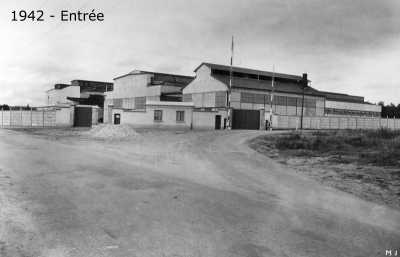
Firstly the main entrance, where you see the SNCF railway siding |

Now we see what used to be the hospital building |
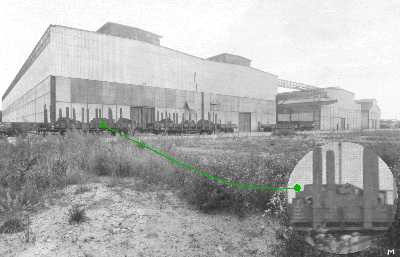
The first buildings erected, from left to right: block J, block C, blocks A and B |
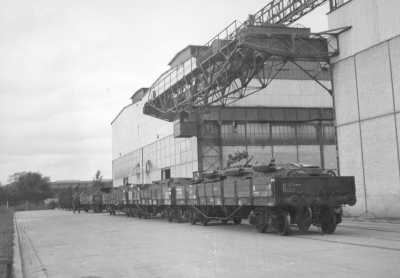
This
shows a loading operation in progress. |
|
However,
the War was not over: three times the factory was bombed; the
Pontlieue works suffered significant damage during the night of
13 to 14 March 1944, with blocks I, H, J and A particularly
affected
. |
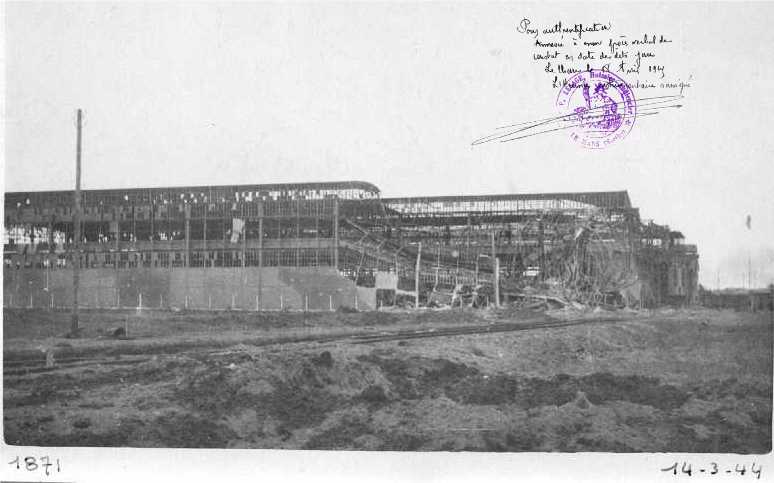 |
For more detailed information
about this period, we recommend reading the book by Gilbert Hatry,
“L’usine Renault du Mans: 1918-1945, with a Preface by Roger Allanic
.
During the war, it was quite natural for production to turn towards the manufacture of gas-powered engines : Renault made several models (in particular, the AFVH).
With regard to agricultural tractor production in France, the interim French Government, in the person of Jean Monnet, drew up a definitive plan delegating complete authority to the Central Committee for Agricultural Equipment to decide the types and quantities of tractors to be manufactured. Consequently, Renault was able to officially register the model 304 at the end of 1944. The petrol shortage favoured Renault’s gas-powered 304H or Himbert, but the factories were in a sorry state, requiring complete reconstruction, and the lack of agricultural tractors was such that the French Government decided, at the beginning of 1945, to take delivery of a large number of American tractors, which did nothing to help the fortunes of Renault.
Translated
by LCI
Campus
de Ker Lann
2,
Allée Gustave Eiffel
F - 35170 BRUZ
Tel : +33 (0)2 99 23 61 61
Fax
: +33 (0)2 99 23 61 62